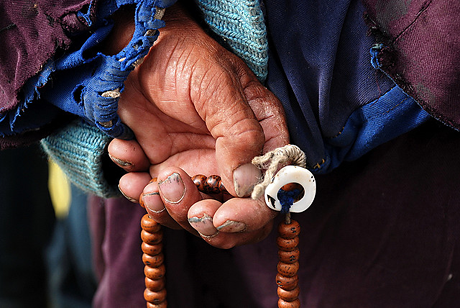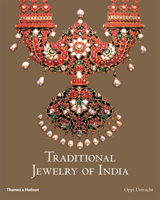
A Ladakhi man thumbs his rosary while listening to a teaching given by the Dalai Lama in Choglamsar, India. (Photo: Tanya May, 2009)
|
The Buddhist rosary described here is used by Tibetan Buddhists, the main Buddhist group living today within the political boundaries of India. Tibetan cultural influence and religion have always been strong among Indian groups who reside along the lengthy Indo-Tibetan Himalayan border area, especially as far as religion and jewelry are concerned.
Buddhist rosaries are used by Lamas or Buddhist priests and all the laity. It is common to see them either worn as a necklace or wrapped as a bracelet around the left wrist. Their constant presence makes them always available for use in leisure time, which is frequently devoted to rosary recitations. Even when occupied with other routine tasks, a Buddhist will commonly count the beads of his or her rosary. They keep accurate count of the number of times each round of rosary recitation has been completed as a mean of gaining merit and to influence an improvement in status in their next incarnation.
The Tibetan rosary (oren-be, a string of beads) normally contains a total of 108 beads, often divided into four groups of 27 each. Sectarian variants may have as may as 111 beads. The extra number above 100, which is considered basic, are there to assure a full count of the prescribed 100-time recitation, allow for any inadvertent miscount, and provide replacements for the loss of beads should a bead or the string of the rosary break. The number 100 corresponds with the original 100 volumes in the Lamaic scriptures, the Kahgyur, now extended to 108 volumes. The number 108 has other mystic significance in Buddhist thought.
At the bottom center of the Tibetan rosary are usually three beads (do dzin, retaining beads), larger than the rest, the central one the largest of the three. These in sequence symbolize the Buddhist trinity: the word (dharma), Buddha, and the Buddhist church (sangha). Attached at anyplace to either side of the rosary, but often at the 8th and 21st bead from this center, are short strings that tightly hold ten small metallic rings or counters. Though variants occur, one of the strings often ends in a miniature thunderbolt (dorje), and this string is used as single unit counters (drabg dzir), each ring representing one round of the rosary. The other string ends with a miniature metal bell (dril-bu) and the rings on it are used to indicate units of ten recitations. In keeping count, when one round of the rosary is completed, one ring on the thunderbolt side is pulled down; when ten on that side are completed, they are all moved back upward, and on the bell side one ring is moved down. It works somewhat in the manner of an abacus. When all counters have been used, a repetition of 10,800 prayers have been said.
Each day a member of the laity may complete from five to twenty cycles; priests, who have more leisure to recite them, say many more. The friction of frequent handling smoothes and wears the beads down; worn beads, more apparent when the rosary is made of an irregularly surfaced organic material such as seeds, are a sign of great piety, obvious to all.
The beads of a Lamaist rosary are made either of mineral or natural organic materials. In the former group are round gold, silver, and hardstone beads, which can be of the most valuable kind, including rubies, emeralds, sapphires, rock crystal, turquoise, and agates. these are used by high Lamas and the wealthy. In the organic natural material group are hard seeds, such as those of the lotus and the rudraksha, and woods such as sandal. Especially favored is wood from the so-called Bodhi tree (Ficus religiosa) under which Buddha sat and attained Enlightenment at Bodh Gaya in Bihar, India. Other organic materials used for beads include pearls, coral, amber, conch shell, ivory, animal and human bone, and, in some cases, snake's vertebrae. A highly prized type used by Tantric Buddhists consists of flat discs of uniform diameter made from human skull bone, that of a Lama if possible. Tibetans do not bury their dead but expose theme to be devoured by vultures and dogs; therefore, human bones are available. Different materials are used to distinguish various sects. Some materials are associated with a particular deity or its manifestation and are used only when they are worshiped. Combinations of different substances may also occur.
Telling the beads, usually by repeating a mystic formula said with a person's tutelary deity in mind, in Tibetan is called tan-c'e, which means "purring like a cat," a reference to the continuous sotto voce murmur of prayer repetitions. The most common Buddhist prayer is the mantra, Om mani padme hum, usually translated as, "Hail to the jewel in the lotus." The "jewel" refers to Buddha's representative, the Bodhisattva Avalokiteshvara (also called Padmapani), the personification of the self-generative, creative cosmic force, reincarnated on Earth in the Dalai Lama.
Buddhist Rosary » Rosaries of India » Traditional Jewelry of India
Oppi Untracht (2008) Thames & Hudson, Inc.

